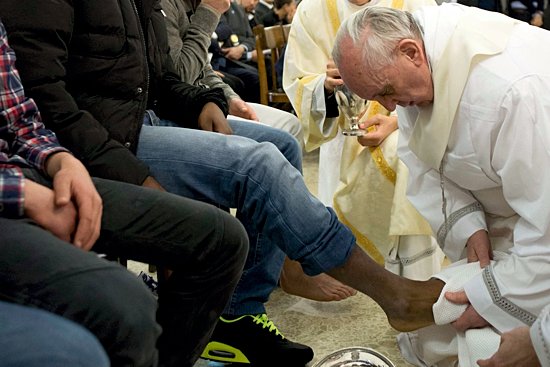
The Eucharist is at the forefront of Holy Thursday. The Easter triduum begins with the Mass of the Lord’s Supper. The liturgy commemorates the institution of the Eucharist by Jesus, the faithful receive the Eucharist during the Communion Rite, the Eucharist is carried in procession at the end of Mass as it is transferred, and the night concludes with eucharistic adoration.
With such a strong emphasis on the Eucharist, it would seem that the Gospel for the Mass should be an account of the institution of the Eucharist, but it is not. Matthew, Mark and Luke each have one available for use. None of them are chosen. Instead, Paul’s account of the institution of the Eucharist is used for the second reading (1 Cor 11:23-26), and the Gospel, the most important Scripture text and the pinnacle of the Liturgy of the Word, is the footwashing. It might seem surprising or out of place. Only John reports the footwashing, and it enjoys the privilege of position and is the major point of emphasis on the night that features the Eucharist.
Why, we might ask. John does not shortchange the Eucharist by not including the institution narrative in his Last Supper account. He devotes almost an entire chapter to the Eucharist — Chapter 6 — the multiplication of the loaves and fishes (Jn 6:1-15) and the Bread of Life discourse (Jn 6:22-59). John wants us to see that the footwashing and the Eucharist are interrelated. Footwashing is eucharistic.
The Eucharist is about the real presence of Christ. Jesus is truly present in the consecrated bread and wine. John’s insight is that Jesus is also truly present in humble service. Jesus did not come to be served, but to serve. He emptied himself for others. During the supper, Jesus took off his outer garments and tied a towel around his waist, the way a servant would dress. Then, kneeling before his disciples, the posture of a servant, he humbly and kindly poured water over each of their feet and then tenderly and lovingly dried them, which is more than a servant was expected to do. It was a heartwarming and gracious act of generous service. Jesus, the teacher and master, gave his disciples a beautiful example of how to serve.
Jesus concluded both the institution of the Eucharist and the footwashing with instructions. After blessing the bread and wine, he said, “Do this in memory of me,” and after washing their feet he said, “As I have done for you, you should also do.” Neither was to be a one-time event. The disciples were supposed to receive the Eucharist over and over again, and they were also to serve others throughout the rest of their lives. Jesus, whose presence they would receive in the Eucharist, was to be carried forth, and when the disciples served others in humility and love, Jesus became truly present in the form of their service. The Eucharist is ordered to service.
Service is demanding, and it requires a great deal of energy. The spiritual energy comes from the Eucharist, which is supplied to the communicant at every Mass, and once dismissed, the person is sent forth to serve others. Service is draining. By the end of the week a person’s energy is spent, the reserve is low, and it is time to return to Mass to be re-energized. It is a continual cycle: Eucharist to service, and service back to the Eucharist.
The foot washing is a perfect Gospel for Holy Thursday because foot washing and the Eucharist are intimately connected. Jesus is made present in both, and the Eucharist leads to service.
Father Van Sloun is pastor of St. Bartholomew in Wayzata. This column is part of an ongoing series on the Eucharist. Read more of his writing at CatholicHotdish.com.



